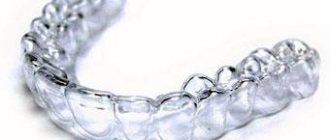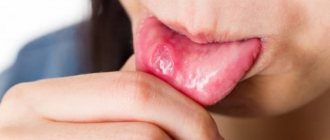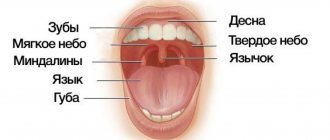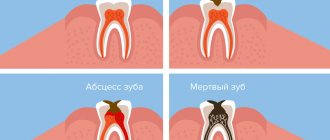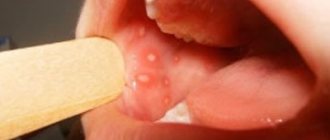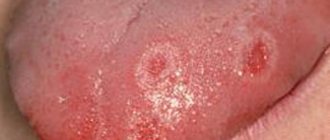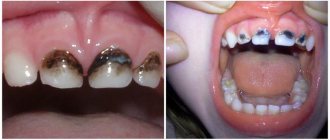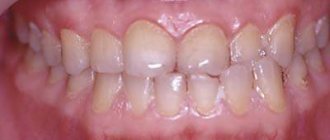Many people have faced this dilemma at least once in their lives. When making a decision, people base their decisions on personal experience, the opinions of friends and acquaintances, and actively search for information on the Internet. If you ask whether it is possible to treat teeth if your throat hurts badly , you get the following answers:
- yes, treat it, because the tooth hurts, and enduring pain is harmful;
- no, you will infect the doctor, and the recovery process after treatment will be delayed.
Interestingly, both sides can be equally right and wrong. Often a sore throat and toothache are related, being the root causes for each other. All that remains is to determine what started to bother you first—the throat or the teeth.
Are sore throat and dental treatment compatible?
Can a tooth cause a sore throat and why does this happen?
Yes, maybe it is explained by anatomical proximity. Therefore, it should be understood that we are talking about molars, and sometimes about “wisdom teeth” located close to the pharynx. If the front incisor and throat hurt at the same time, then they are unlikely to be somehow connected. And inflammation, especially purulent, of a molar can spread to the tonsils and submandibular lymph nodes, causing discomfort in the larynx and redness of the mucous membranes; Other symptoms include gingivitis and imaginary ear pain.
Accordingly, they first go to the dentist to solve the problem with a bad tooth. After treatment, doctors prescribe rinses with antiseptic solutions, which also cope with sore throats.
Complications after prosthetics
- The development of inflammation of the gingival tissue - as a result, leads to gingivitis, stomatitis in acute and chronic forms. As a rule, such a complication in the oral cavity occurs due to poor fit of the tooth replacement structure. The process goes like this: the structure puts pressure on the tissue, blood vessels die, there is no blood supply to the tissue, and inflammation develops.
- Carious formations - as a result, the supporting teeth are affected by pulpitis or periodontitis. This usually occurs due to the accumulation of food debris between the prosthetic structure and living tissues. The problem leads to the fact that the teeth are gradually destroyed, cease to perform their supporting functions, and the fixation of the prosthesis is disrupted.
- Infectious lesions of soft and bone tissues – periodontitis. Often obvious destructive changes are noticeable around the product: the gums acquire a bluish tint, swelling and bleeding of the tissue develops. As a result, this leads to tooth loss and disruption of the fixation of the replacement structure.
- Rejection of the structure due to an allergic reaction. It can manifest itself as swelling of the gums, itching, rash and redness in the mouth. In some cases, difficulty breathing and a constant feeling of dry mouth and fever may occur. Allergies may appear in the first few hours after installation of the structure or after several weeks.
- The development of galvanism leads to the generation of galvanic current. What usually happens when using structures with a metal frame is that saliva gets on the material, the patient feels a taste of iron in the mouth, a constant feeling of an acidic environment in the oral cavity, and discomfort. As a result, the crowns darken, aesthetics are impaired, and sometimes the problem is accompanied by a headache.
- Poor quality fixation of the product. As a rule, the product “sits” on a special dental cement, which does not always hold the product in the oral cavity. The prosthesis may come off due to overload, incorrectly selected shape or size of the prosthesis. It is also possible that the dentist did not use enough dental cement for bonding. Sometimes fillings on the teeth prevent the prosthesis from “adhering” to living tissue.
- Product deformation. These can be chips, cracks, breaks, breaks into halves or small parts. The denture can become deformed due to impacts to the jaw projection, accidents, falls, or eating too hard foods. Sometimes the product is deformed due to errors in prosthetic planning.
- Problems with the occlusal plane. We are mainly talking about the surface that passes through the cutting edges of the first incisors of the lower jaw and the tubercles of wisdom teeth or second molars. The plane may shift, causing the temporomandibular joint to suffer.
- Change in bite. The height of dental crowns plays a big role. For example, with a lack of height, the quality of chewing decreases - a low-quality food bolus is formed. When the height of the crowns is high, the jaw is overloaded, which provokes dysfunction of the temporomandibular joint.
How to solve a problem?
The dentist recommends treating the oral cavity with antiseptic solutions, as well as special gels to activate tissue regeneration processes. With regular treatment and oral care, the gums are soothed.
How to solve a problem?
At least twice a year (or even more often) undergo a full examination by a dentist. Not a single prosthesis, even a well-made one, will stand in such a way that bacteria will not accumulate under it. Care for the cavity with such products should be twice as thorough as usual!
How to solve a problem?
First, the dentist must prepare the teeth without creating so-called ledges. Secondly, the design must be selected strictly; several fittings and adjustments of the product may be required. Thirdly, before installing a prosthetic product, it is necessary to treat the gums. Regular therapy may be needed to maintain the health of the oral soft tissues.
How to solve a problem?
It is necessary to establish which component of the prosthetic structure the patient is allergic to. Most likely, the prosthesis will have to be replaced. That is why, at the stage of planning prosthetics, it is important to study the medical history and make sure that the patient does not have an allergy to metal.
How to solve a problem?
Replace the prosthesis with a product made of ceramic material. When installing ceramic structures, galvanism does not occur.
How to solve a problem?
Determine exactly why the prosthesis is poorly fixed and perform re-fixation with correction of inaccuracies.
How to solve a problem?
If the deformation is minor, the structure can be repaired directly in the oral cavity. Sometimes removal and re-fixation may be necessary. If the damage is serious, the prosthesis will have to be removed and a new one put in its place.
How to solve?
Since the problem is global, most likely, it is necessary to re-plan the prosthetics with a thorough diagnosis of the bite and the production of a new prosthetic structure.
How to solve a problem?
Determine the main cause of the development of malocclusion, re-plan prosthetics with replacement of the structure.
Is it possible to treat teeth if you have a cold?
90% of specialists will answer this with a firm “no,” citing the following arguments:
- A healthy body has more strength for regeneration, which will be needed to heal inflamed gums, mucous membranes, sprout new nerve endings and stop bleeding.
- The effect of local anesthetics is reduced, because During inflammatory processes in tissues, the pH of the environment changes to the acidic side. A large dose of the same procaine is required to achieve complete pain relief. Increased doses of medications can cause allergic reactions. Considering that the manipulations are carried out near the throat, this is fraught with Quincke's edema.
- With a wet cough, sputum is actively expelled. At the most inopportune moment, you can cough in the doctor’s face, and healing also worsens. Sputum is characterized by the content of not only dead microorganisms, but also living, pathogenic ones. If it gets on inflamed gums, it can cause infection and complications including osteitis (bone inflammation) and sepsis.
Carrying out FGDS
The FGDS procedure lasts no more than ten minutes. If a biopsy is needed, it will take a little longer.
The patient is placed on his left side, after which the oral cavity and larynx are treated with a local anesthetic to reduce sensitivity.
A mouthpiece is placed in the mouth, through which the endoscopist inserts a tube with a probe. The doctor moves it deeper with gentle movements, examining the inner walls of the duodenum and stomach. If an ulcer or tumor is found, he will take a tissue sample for a biopsy. He will also remove detected polyps if necessary.
FGDS is a safe procedure, but in some cases it causes pain. Most often this occurs with ulcers or cancerous tumors. In these cases, the patient is recommended to undergo diagnostics under anesthesia.
Why is dental treatment not recommended for sore throat?
A sore throat prevents you from opening your mouth wide, as dentists like. The patient will not sit through the entire procedure with inflamed and tense tissues of the pharynx, and the doctor will not provide the service of the required quality.
In addition, fear of the dentist, layered with fever and sore throat, will cause additional stress and completely undermine the body.
In bacterial forms of sore throat, the tongue is heavily coated with plaque containing microorganisms. This is a danger to the doctor and the patient’s health (autoinfection).
If we summarize all of the above, it turns out that it is better to reschedule the visit to the clinic. After all, with such strong-willed decisions, dentists take care of the health of both themselves and their patients. But sometimes these rules are deviated from in order to help people with sore throats.
How to relieve toothache during a cold
There are a hundred ways to relieve toothache, but only a dozen methods will be effective. Common control options include:
- non-steroidal anti-inflammatory drugs (NSAIDs) . When people have a cold, they resort to Fervex, Theraflu, Antigrippin and other drugs containing paracetamol. So why not replace the old and harmful paracetamol with a modern, soft and effective nimesulide or meloxicam? Both of the latter substances easily reduce temperature, block pain and fight inflammation;
- local anesthesia . Novocaine or lidocaine is applied to a cotton swab and applied to the diseased area. A sophisticated method suggests crushing 1 tablet of No-shpa (drotaverine) and pouring the resulting powder onto the affected area in the mouth. In both cases, the treated area becomes numb for 2-3 hours;
- traditional methods . The pulse is found on the arm on the opposite side and a clove of garlic is tied. The mechanism is not clear, but the pain subsides;
- warming up The method is effective, but dangerous: purulent inflammations cannot be heated, because this provokes the melting of surrounding tissues by pus enzymes. And only a doctor can tell about the nature of the inflammation.
The listed methods only relieve symptoms, which shortens the time of an attack of acute pain, but do not treat teeth.
And one last thing. Toothache only seems like a trifle at first - people endure it for days because of fear of dentists - but it is fraught with many dangers, just like a cold that is not cured in time. Take care of yourself and take care of your health. You are alone!
Moscow metro station Zvezdnaya, Danube Avenue, 23
Causes of inflammation
An allergic reaction to the materials from which the prosthesis is made. This can include a plastic base (residual monomer in its composition), dyes, metal alloys, etc.
The uncomfortable base of the removable structure, resting on the mucous membrane, can rub or press unnecessarily, causing redness, pain and discomfort, especially when chewing.
incorrectly made crown that goes deep into the periodontal sulcus will injure the gums, also causing inflammation - gingivitis. Destruction of the circular ligament leads to free penetration of microflora into the marginal periodontal area, which causes the development of periodontitis.
incorrectly made bridge , due to the supports, can have the same traumatic effect as a crown. Also, the intermediate (washing) part of the bridge resting on the mucous membrane leads to the accumulation of food debris, complicates hygiene, and sometimes causes the formation of ulcers and welts under the structure.
Poor hygiene and oral care leads to the accumulation of plaque, food debris, the formation of tartar and gum pockets. Which in turn is a trigger for the development of periodontal diseases, which is accompanied by inflammation, unpleasant odor, bleeding gums and the formation of pathological periodontal pockets with root exposure.
Changing the load on the prosthesis. This often happens after the loss of a side group of teeth and a long absence of their replacement. In this case, the chewing load is distributed only to the remaining supports, which leads to their overload and a corresponding periodontal reaction.
Painful sensations in the gums and inflammation of the mucous membrane may indicate the presence of pulpitis, periodontitis, periodontitis and other common diseases. The appearance of swelling, redness, and severe pain under the structure may be evidence that serious pathological changes are occurring in the jaw bone, requiring a visit to a dental clinic and the appointment of effective treatment.


